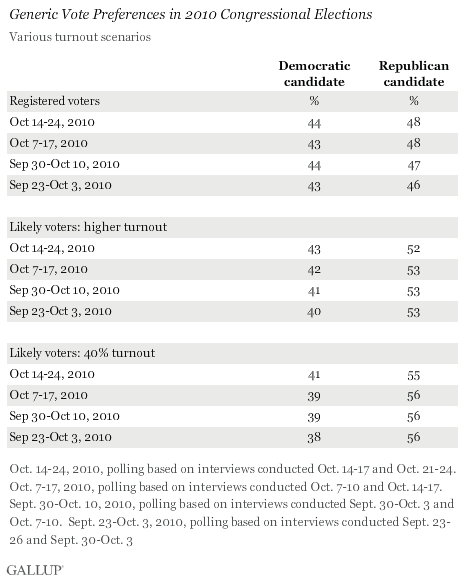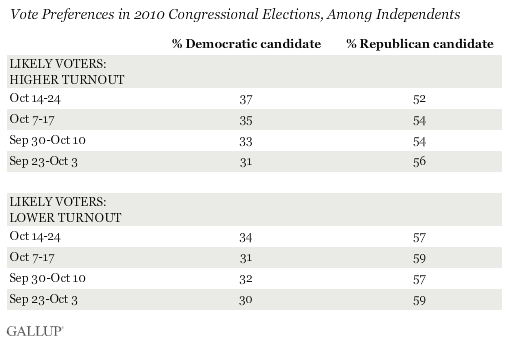PRINCETON, NJ -- Republicans remain in position to win control of the House of Representatives in next week's midterm elections, although Democrats are doing slightly better now than they were early in October. Gallup's latest two-week average on its generic ballot for Congress shows Republicans retaining a 48% to 44% margin among all registered voters, a 52% to 43% margin among likely voters in a high-turnout scenario, and a 55% to 41% margin in a low-turnout scenario. These likely voter advantages for the Republicans are slightly smaller than in previous weeks, reflecting in particular increased Democratic strength over the most recent days of interviewing.

An increase in Democratic positioning in the last weeks of the midterm campaign is not historically atypical, nor is it necessarily surprising in light of the campaigning and efforts Democrats are putting forth as they work to narrow the enthusiasm gap Republicans have enjoyed all year.
However, Democrats would need to generate a substantial narrowing of the margin among likely voters over the last week of this campaign in order to prevent Republicans from gaining enough seats to take over control of Congress. Gallup's statistical estimates based on historical U.S. House-vote data by party suggest that the Republicans need a 52% share of the two-party national House vote to be in a position to win control of the House.
More than 90% of Democratic and Republican likely voters continue to say they will vote for their party's candidate in the House. This high degree of partisan loyalty has not changed substantially over the last four weeks.
Independent likely voters remain substantially more likely to support the GOP candidate in their district than the Democratic candidate. However, the Republican margin among independents has narrowed. Independents who are likely voters have moved from giving Republicans a 25-point advantage in late September/early October to a 15-point margin today. Under a low-turnout scenario, the Republican margin among independents has dropped from 29 points to 23 points.

Republicans remain more enthusiastic about voting than Democrats. Gallup has tracked a measure of enthusiasm since March, and at this point among registered voters, 48% of Republicans say they are very enthusiastic about voting in the elections, compared with 36% of Democrats. This 12-point Republican advantage on enthusiasm is slightly smaller than the enthusiasm margins obtained in late September and early October, and smaller than most of the margins measured from March through August.
The percentage of Americans who have given quite a bit of or some thought to the election has inched up slightly in recent weeks, as would be expected as the election draws nearer, from 46% in Gallup's Sept. 23-Oct. 3 report to 51% now. Republicans are more likely than Democrats to have given quite a lot of or some thought to the elections, by a 62% to 49% margin.
Implications
American voters will be bombarded with intensified campaign efforts from all sides during the final week of the campaign. President Barack Obama this week alone will be campaigning for Democratic candidates in Rhode Island, Pennsylvania, Connecticut, Illinois, and Ohio. Vice President Joe Biden will be in New York, Pennsylvania, Maryland, Iowa, Massachusetts, and in Ohio with President Obama. Both Democrats and Republicans will be spending millions more on broadcast commercials, mail material, and voter mobilization efforts.
The relatively stable voting intentions of registered voters over the last five weeks suggests that the basic, underlying structure of the race has not changed significantly -- if all voters were to turn out and vote. Of course, that "100% voting" scenario will not occur, making the difference in turnout between those voting for each of the two major-party candidates a critical determinant of the election's ultimate outcome.
Republicans have held the upper hand all year in terms of enthusiasm and turnout, giving their candidates clear advantages among likely voters. Democrats appear to have closed that gap a little, particularly when the last four days of Gallup's interviewing are taken into account, and are thus doing slightly better in Gallup's voting estimates. How much Democrats may be able to continue to close that gap, if at all, is the major story of the campaign's final week, although at this point, the Republicans' chances of taking over the House remain good.
Learn more about Gallup's likely voter models for the 2010 midterm congressional elections.
Results for this Gallup poll are based on telephone interviews conducted Oct. 14-17 and Oct. 21-24, 2010, with a random sample of 3,051 adults, aged 18 and older, living in the continental U.S., selected using random-digit-dial sampling.
For results based on the total sample of national adults, one can say with 95% confidence that the maximum margin of sampling error is ±2 percentage points.
For results based on the total sample of 2,746 registered voters, one can say with 95% confidence that the maximum margin of sampling error is ±2 percentage points.
For results based on the sample of 1, 989 likely voters, the maximum margin of sampling error is ±3 percentage points.
Interviews are conducted with respondents on landline telephones (for respondents with a landline telephone) and cellular phones (for respondents who are cell phone-only). Each sample includes a minimum quota of 150 cell phone-only respondents and 850 landline respondents, with additional minimum quotas among landline respondents for gender within region. Landline respondents are chosen at random within each household on the basis of which member had the most recent birthday.
Samples are weighted by gender, age, race, education, region, and phone lines. Demographic weighting targets are based on the March 2009 Current Population Survey figures for the aged 18 and older non-institutionalized population living in continental U.S. telephone households. All reported margins of sampling error include the computed design effects for weighting and sample design.
In addition to sampling error, question wording and practical difficulties in conducting surveys can introduce error or bias into the findings of public opinion polls.
View methodology, full question results, and trend data.
For more details on Gallup's polling methodology, visit www.gallup.com.
